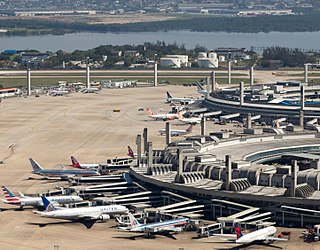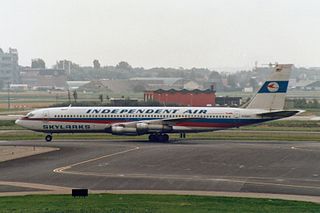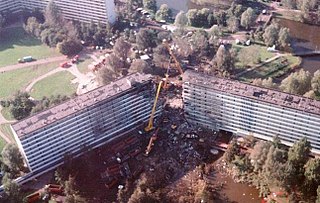Lufthansa Cargo AG is a German cargo airline and a wholly owned subsidiary of Lufthansa. It operates worldwide air freight and logistics services and is headquartered at Frankfurt Airport, the main hub of Lufthansa. Besides operating dedicated cargo planes, the company also has access to cargo capacities of 350 passenger aircraft of the Lufthansa Group.

Rio de Janeiro/Galeão–Antonio Carlos Jobim International Airport, popularly known by its original name Galeão International Airport, is the main international airport serving Rio de Janeiro, Brazil.

Trans World Airlines (TWA) Flight 159 was a regularly scheduled passenger flight from New York City to Los Angeles, California, with a stopover in Cincinnati/Northern Kentucky International Airport, Kentucky, that crashed after an aborted takeoff from Cincinnati on November 6, 1967. The Boeing 707 attempted to abort takeoff when the copilot became concerned that the aircraft had collided with a disabled DC-9 on the runway. The aircraft overran the runway, struck an embankment and caught fire. One passenger died as a result of the accident.

Garuda Indonesia Flight 152 (GA152/GIA152) was a scheduled domestic flight operated by Garuda Indonesia from Soekarno–Hatta International Airport, Tangerang, to Polonia International Airport, Medan, in Indonesia. On 26 September 1997, the aircraft flying the route crashed into mountainous woodlands near the village of Buah Nabar, Sibolangit, killing all 222 passengers and 12 crew members on board. It is the deadliest aviation disaster in Indonesia's history.

On 8 February 1989, Independent Air Flight 1851, a Boeing 707 on an American charter flight from Bergamo, Italy, to Punta Cana, Dominican Republic, struck Pico Alto while on approach to Santa Maria Airport in the Azores for a scheduled stopover. The aircraft was destroyed, with the loss of all 144 people on board, resulting in the deadliest plane crash in Portugal's history. All of the passengers on board were Italian and all of the crew were Americans. The crash is also known as "The disaster of the Azores".

Pan Am Flight 812 (PA812), operated by a Pan Am Boeing 707-321B registered N446PA and named Clipper Climax, was a scheduled international flight from Hong Kong to Los Angeles, California, with intermediate stops at Denpasar, Sydney, Nadi, and Honolulu. The airplane briefly appeared in the Willy Wonka and the Chocolate Factory movie in 1971. On April 22, 1974, it crashed into rough mountainous terrain while preparing for a runway 09 approach to Denpasar after a 4-hour 20-minute flight from Hong Kong. All 107 people on board perished. The location of the accident was about 42.5 nautical miles northwest of Ngurah Rai International Airport. Until the 1991 Jakarta Indonesian Air Force C-130 crash, it was the deadliest aviation accident to happen on Indonesian soil.

Varig Flight 797 was a flight from Abidjan, Ivory Coast to Rio de Janeiro, Brazil. On 3 January 1987, the Boeing 707-320C crashed while landing, killing all 12 crew members and 38 of the 39 passengers. After an engine failure, the pilot decided to return but misjudged the approach and stalled the aircraft. It crashed onto a rubber plantation in the midst of the jungle, 18 kilometres from the airport at a speed of 400 kilometres per hour. Many passengers who survived the initial crash died in the fire that followed.

On 4 October 1992, El Al Flight 1862, a Boeing 747 cargo aircraft of the Israeli airline El Al, crashed into the Groeneveen and Klein-Kruitberg flats in the Bijlmermeer neighbourhood of Amsterdam, the Netherlands. The accident is known in Dutch as the Bijlmerramp.

Galeão Air Force Base – ALA11 is a base of the Brazilian Air Force located in Rio de Janeiro, Brazil. It is named after nearby Praia do Galeão, where in 1663 the galleon Padre Eterno was built.

Sudan Airways Flight 2241 was a scheduled cargo flight from Sharjah, United Arab Emirates to Khartoum, Sudan operated by a Boeing 707-330C. On 21 October 2009, the cargo plane's No. 4 engine cowling separated during lift off, and in an attempt to turn the plane around, it stalled and crashed north of the airport. All six occupants were killed.
VARIG was the first airline founded in Brazil, in 1927. From 1965 until 1990, it was Brazil's leading airline and virtually its only international one. In 2005, Varig went into judicial restructuring, and in 2006 it was split into two companies – Flex Linhas Aéreas, informally known as "old" Varig, heir to the original airline – now defunct, and "new" Varig, a new company, fully integrated into Gol Airlines.

Varig Flight 967 was an international cargo flight from Narita International Airport in Japan to Rio de Janeiro–Galeão International Airport in Brazil, with a stopover at Los Angeles International Airport in the United States. On 30 January 1979, the Boeing 707-323C serving the flight disappeared while en route. Neither the aircraft nor its six crew members have ever been found.

Lufthansa Flight 502 was a scheduled flight from Hamburg, Germany to Buenos Aires, Argentina on 11 January 1959. The flight was being operated by a Lockheed L-1049G Super Constellation. On the leg between Senegal and Brazil the Super Constellation was on approach to Rio de Janeiro–Galeão International Airport when it crashed near Flecheiras Beach just short of the runway. All 29 passengers and seven of the ten crew were killed. It was the first fatal accident involving the current Lufthansa since it was formed in 1955.

ADC Airlines Flight 086 (ADK086) was a Nigerian domestic flight operated by ADC Airlines from Port Harcourt to Lagos. On the afternoon of 7 November 1996, the crew of the Boeing 727-200 operating the flight lost control of the aircraft while avoiding a mid-air collision on approach; the aircraft crashed inverted at a very high speed into a lagoon, killing all 144 passengers and crew on board. The crash remains as the fourth worst plane crash in Nigerian history.

Varig Flight 810 was a scheduled international passenger flight from Rio de Janeiro to Los Angeles with stopovers in Lima, Bogotá, Panama City, and Mexico City. On 27 November 1962, the Boeing 707-441 operating the route crashed into a mountain on approach to Lima, killing all 97 passengers and crew. At the time it was the deadliest aviation accident in Peru until being surpassed by LANSA Flight 502 in 1971 and later Faucett Perú Flight 251 in 1996.

Imperial Iranian Air Force Flight 48 was a military cargo flight from Tehran, Iran, to McGuire Air Force Base in the United States with a stopover in Madrid, Spain. On May 9, 1976, the Boeing 747-131 freighter operating the flight crashed during its approach to Madrid, killing all 17 people on board.

Trans-Air Service Flight 671 was a cargo flight from Luxembourg Airport to Mallam Aminu Kano International Airport in Kano, Nigeria. While flying over France on March 31, 1992, the Boeing 707 operating the flight experienced an in-flight separation of two engines on its right wing. Despite the damage to the aircraft, the pilots were able to perform an emergency landing at Istres-Le Tubé Air Base in Istres, France. All five occupants of the aircraft survived; the aircraft was damaged beyond repair due to a fire on the right wing.

Hinduja Cargo Services Flight 8533 was a scheduled cargo flight from Tribhuvan International Airport in Nepal to Indira Gandhi International Airport in India operated by Lufthansa Cargo's Indian subsidiary Hinduja Cargo Services. On 7 July 1999, the Boeing 727 operating the flight crashed into Champadevi Hills at 2,200 metres (7,200 ft) altitude with no survivors amongst the 5 occupants on board.
















